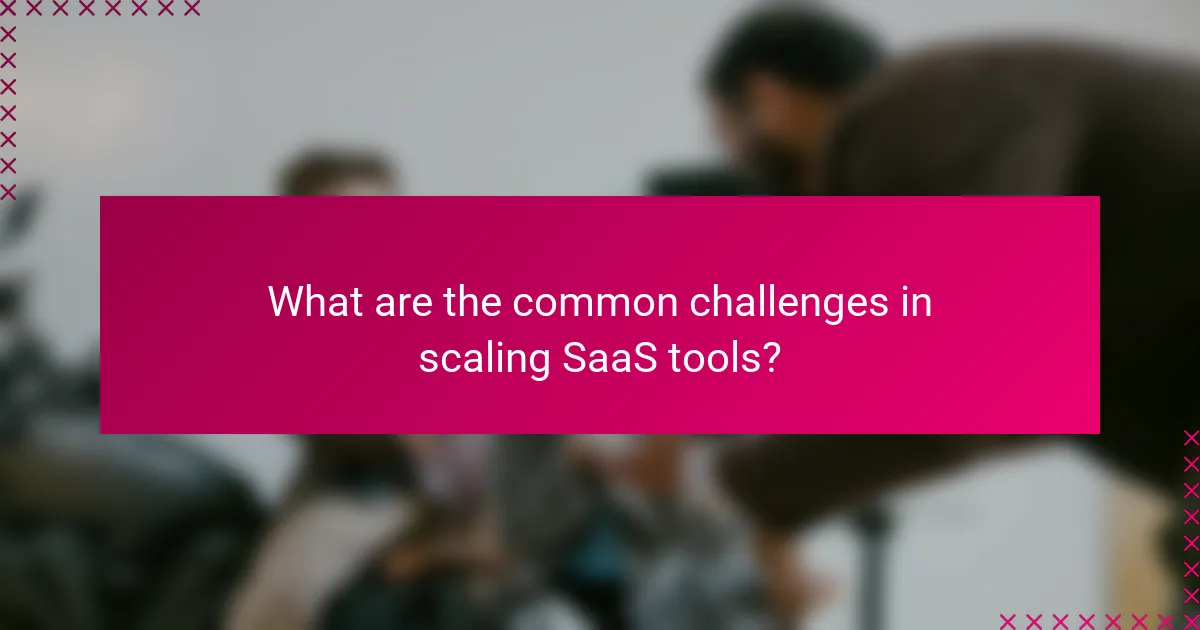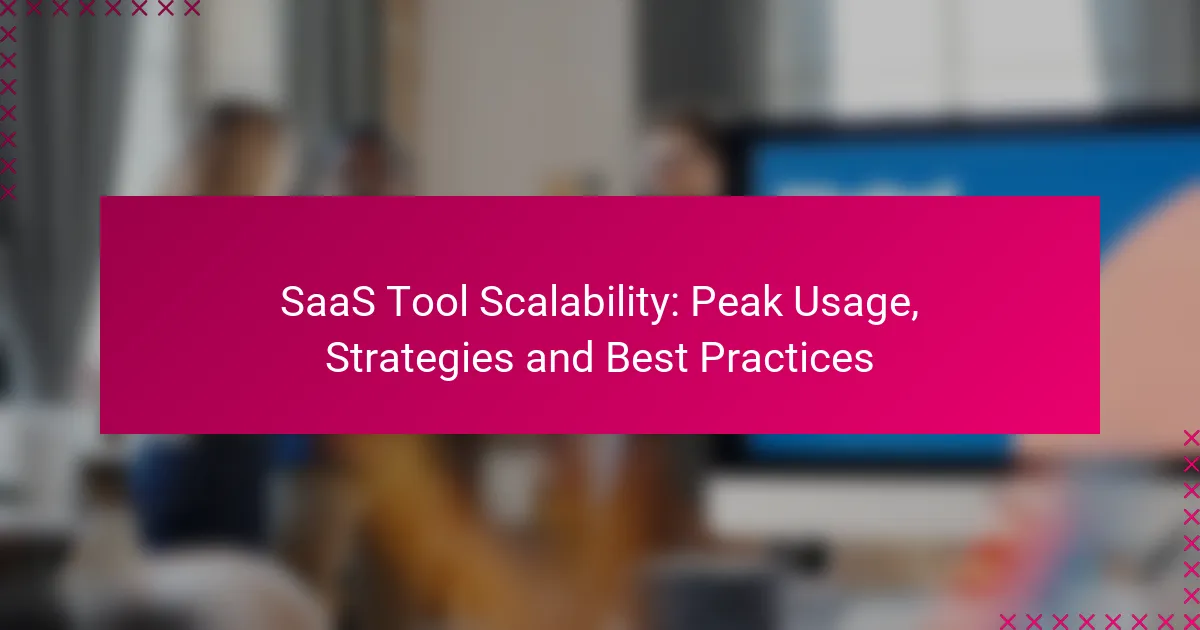Scalability is crucial for SaaS tools, especially during peak usage periods, as it ensures consistent performance and reliability. Implementing strategies such as load balancing, auto-scaling, and performance monitoring can significantly enhance an application’s ability to manage increased demands. Additionally, adopting microservices architecture and leveraging cloud services further optimize scalability, allowing for efficient resource management and improved user experiences.

How to manage peak usage in SaaS tools in Canada?
Managing peak usage in SaaS tools in Canada requires a combination of strategies to ensure performance and reliability. Key approaches include load balancing, auto-scaling, performance monitoring, utilizing CDNs, and deploying regional data centers.
Load balancing techniques
Load balancing distributes incoming traffic across multiple servers, preventing any single server from becoming overwhelmed. This technique can enhance responsiveness and availability during peak usage times.
Consider using round-robin, least connections, or IP hash methods for load balancing. Each method has its advantages depending on your application’s architecture and user patterns.
Auto-scaling features
Auto-scaling automatically adjusts the number of active servers based on current demand. This ensures that your SaaS tool can handle sudden spikes in usage without manual intervention.
Implementing auto-scaling requires setting thresholds for CPU usage or response times. For instance, you might configure your system to add servers when CPU usage exceeds 70% for a sustained period.
Performance monitoring tools
Performance monitoring tools track the health and responsiveness of your SaaS application. They provide insights into system performance, helping you identify bottlenecks during peak usage.
Utilize tools like New Relic or Datadog to monitor key metrics such as response times, error rates, and server load. Regularly reviewing these metrics can help you proactively address potential issues.
Content Delivery Networks (CDNs)
CDNs enhance the delivery speed of your SaaS application by caching content closer to users. This reduces latency and improves load times, especially during high traffic periods.
When selecting a CDN, consider providers like Cloudflare or Akamai, which have extensive networks in Canada. A CDN can significantly offload traffic from your main servers, allowing them to focus on dynamic content processing.
Regional data centers
Using regional data centers can improve performance and compliance with local regulations. By hosting your SaaS application closer to your users, you can reduce latency and enhance user experience during peak times.
Evaluate options for data centers in Canada, ensuring they meet standards such as ISO 27001 for information security. This can also help with data residency requirements under Canadian privacy laws.

What strategies enhance SaaS scalability?
Enhancing SaaS scalability involves implementing strategies that allow applications to handle increased loads efficiently. Key approaches include adopting microservices architecture, utilizing API integrations, leveraging cloud service providers, and employing containerization with tools like Docker.
Microservices architecture
Microservices architecture breaks down applications into smaller, independent services that can be developed, deployed, and scaled individually. This modular approach allows teams to update or scale specific components without affecting the entire system, enhancing flexibility and reducing downtime.
When considering microservices, ensure that each service communicates effectively, often using lightweight protocols like HTTP or messaging queues. This architecture is particularly beneficial for applications experiencing variable traffic patterns, as it allows for targeted resource allocation.
API integrations
API integrations facilitate communication between different software applications, enabling them to share data and functionalities seamlessly. By leveraging APIs, SaaS products can extend their capabilities and integrate with third-party services, enhancing overall scalability.
To maximize the benefits of API integrations, prioritize well-documented and stable APIs that support high traffic. Consider implementing rate limiting and caching strategies to manage load effectively and ensure that your application remains responsive during peak usage.
Cloud service providers
Utilizing cloud service providers allows SaaS applications to scale resources on-demand, accommodating fluctuating user loads without the need for significant upfront investment. Providers like AWS, Azure, and Google Cloud offer various services that can be tailored to specific scalability needs.
When selecting a cloud provider, evaluate their pricing models, performance metrics, and support options. It’s crucial to choose a provider that aligns with your scalability goals and can handle anticipated growth without compromising service quality.
Containerization with Docker
Containerization with Docker enables developers to package applications and their dependencies into containers, ensuring consistency across different environments. This approach simplifies deployment and scaling, as containers can be easily replicated and managed across various infrastructures.
To effectively use Docker for scalability, implement orchestration tools like Kubernetes to automate the deployment, scaling, and management of containerized applications. This setup allows for rapid scaling in response to user demand while maintaining operational efficiency.

What are the best practices for SaaS scalability?
Best practices for SaaS scalability focus on ensuring that your software can handle increased loads without compromising performance. Key strategies include regular performance testing, implementing redundancy, optimizing database queries, and utilizing caching mechanisms.
Regular performance testing
Regular performance testing is crucial for identifying bottlenecks before they affect users. This involves simulating peak usage scenarios to assess how your SaaS application behaves under stress. Tools like JMeter or LoadRunner can help in conducting these tests effectively.
Consider testing at various stages of development and deployment to ensure that any changes do not introduce new issues. Aim to test at least quarterly, or more frequently if your application undergoes significant updates.
Implementing redundancy
Implementing redundancy ensures that your SaaS application remains operational even if a component fails. This can include server redundancy, where multiple servers handle the same requests, or data redundancy, where data is replicated across different locations.
Using cloud services like AWS or Azure can simplify redundancy management, as they offer built-in solutions for failover and load balancing. Regularly review your redundancy strategies to adapt to changing user demands and technological advancements.
Optimizing database queries
Optimizing database queries is essential for maintaining performance as your user base grows. This involves analyzing and refining SQL queries to reduce execution time and resource consumption. Use tools like EXPLAIN to identify slow queries and optimize them accordingly.
Consider indexing frequently accessed data and avoiding complex joins when possible. Regularly review your database performance metrics to identify areas for improvement and ensure efficient data retrieval.
Utilizing caching mechanisms
Utilizing caching mechanisms can significantly enhance the speed and efficiency of your SaaS application. Caching stores frequently accessed data in memory, reducing the need to fetch it from the database repeatedly. Common caching solutions include Redis and Memcached.
Implement caching at various levels, such as application-level caching for dynamic content and CDN caching for static assets. Monitor cache hit rates to optimize your caching strategy and adjust as necessary to balance performance and resource usage.

How to evaluate SaaS tool scalability?
Evaluating SaaS tool scalability involves assessing how well the software can handle increased loads without performance degradation. Key factors include infrastructure flexibility, resource allocation, and the ability to maintain service quality during peak usage periods.
Scalability assessment frameworks
Scalability assessment frameworks provide structured approaches to evaluate a SaaS tool’s ability to grow. Common frameworks include the Capacity Planning Model, which focuses on resource management, and the Load Testing Model, which simulates user demand to identify potential bottlenecks.
When using these frameworks, consider both vertical scaling (adding more power to existing servers) and horizontal scaling (adding more servers). Each approach has its trade-offs, such as cost implications and complexity in management.
Key performance indicators (KPIs)
Key performance indicators (KPIs) are essential for measuring scalability. Important KPIs include response time, throughput, and error rates during peak usage. Monitoring these metrics helps identify when the system is nearing its limits.
Establish baseline performance metrics under normal conditions and compare them against performance during peak times. Aim for response times in the low tens of milliseconds and error rates below 1% to ensure a good user experience.
User feedback mechanisms
User feedback mechanisms are crucial for understanding scalability issues from the end-user perspective. Implement surveys, feedback forms, and user interviews to gather insights on performance during high-demand periods.
Regularly analyze feedback to identify patterns or recurring issues, and prioritize fixes based on user impact. This proactive approach can help mitigate scalability challenges before they affect a larger user base.

What are the common challenges in scaling SaaS tools?
Scaling SaaS tools presents several challenges, including managing costs, handling data migration, and integrating with existing systems. Addressing these issues effectively is crucial for maintaining performance and ensuring user satisfaction during growth phases.
Cost management issues
Cost management is a significant challenge when scaling SaaS tools, as expenses can rise sharply with increased usage. It’s essential to monitor resource consumption closely and implement cost-effective strategies to avoid budget overruns.
Consider adopting a tiered pricing model that aligns with user growth, allowing for predictable costs as customer demand increases. Regularly review your cloud service agreements to ensure you are getting the best value for your resources.
Data migration complexities
Data migration can be a complex process when scaling SaaS tools, especially if you’re transitioning from legacy systems or integrating new features. Ensuring data integrity and minimizing downtime during migration are critical to maintaining user trust.
Develop a detailed migration plan that includes data mapping, validation, and testing phases. Utilize automated tools where possible to streamline the process and reduce the risk of errors.
Integration hurdles
Integrating new functionalities or third-party services can pose significant hurdles during the scaling of SaaS tools. Compatibility issues may arise, leading to potential disruptions in service delivery.
To mitigate integration challenges, prioritize using APIs that are well-documented and widely supported. Establish a robust testing environment to evaluate integrations before full deployment, ensuring that they work seamlessly with existing systems.
